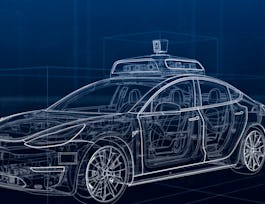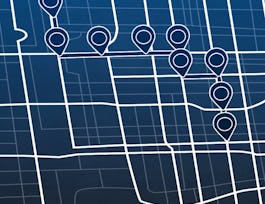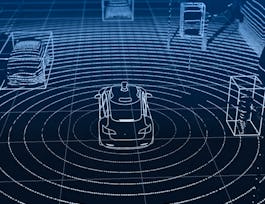Welcome to State Estimation and Localization for Self-Driving Cars, the second course in University of Toronto’s Self-Driving Cars Specialization. We recommend you take the first course in the Specialization prior to taking this course.



State Estimation and Localization for Self-Driving Cars
This course is part of Self-Driving Cars Specialization


Instructors: Jonathan Kelly
52,065 already enrolled
Included with 
(826 reviews)
Recommended experience
What you'll learn
Understand the key methods for parameter and state estimation used for autonomous driving, such as the method of least-squares
Develop a model for typical vehicle localization sensors, including GPS and IMUs
Apply extended and unscented Kalman Filters to a vehicle state estimation problem
Apply LIDAR scan matching and the Iterative Closest Point algorithm
Details to know

Add to your LinkedIn profile
1 quiz, 4 assignments
See how employees at top companies are mastering in-demand skills

Build your subject-matter expertise
- Learn new concepts from industry experts
- Gain a foundational understanding of a subject or tool
- Develop job-relevant skills with hands-on projects
- Earn a shareable career certificate


Earn a career certificate
Add this credential to your LinkedIn profile, resume, or CV
Share it on social media and in your performance review

There are 6 modules in this course
This module introduces you to the main concepts discussed in the course and presents the layout of the course. The module describes and motivates the problems of state estimation and localization for self-driving cars. An accurate estimate of the vehicle state and its position on the road is required at all times to drive safely.
What's included
9 videos3 readings1 discussion prompt
The method of least squares, developed by Carl Friedrich Gauss in 1795, is a well known technique for estimating parameter values from data. This module provides a review of least squares, for the cases of unweighted and weighted observations. There is a deep connection between least squares and maximum likelihood estimators (when the observations are considered to be Gaussian random variables) and this connection is established and explained. Finally, the module develops a technique to transform the traditional 'batch' least squares estimator to a recursive form, suitable for online, real-time estimation applications.
What's included
4 videos3 readings3 assignments2 ungraded labs
Any engineer working on autonomous vehicles must understand the Kalman filter, first described in a paper by Rudolf Kalman in 1960. The filter has been recognized as one of the top 10 algorithms of the 20th century, is implemented in software that runs on your smartphone and on modern jet aircraft, and was crucial to enabling the Apollo spacecraft to reach the moon. This module derives the Kalman filter equations from a least squares perspective, for linear systems. The module also examines why the Kalman filter is the best linear unbiased estimator (that is, it is optimal in the linear case). The Kalman filter, as originally published, is a linear algorithm; however, all systems in practice are nonlinear to some degree. Shortly after the Kalman filter was developed, it was extended to nonlinear systems, resulting in an algorithm now called the ‘extended’ Kalman filter, or EKF. The EKF is the ‘bread and butter’ of state estimators, and should be in every engineer’s toolbox. This module explains how the EKF operates (i.e., through linearization) and discusses its relationship to the original Kalman filter. The module also provides an overview of the unscented Kalman filter, or UKF, a more recently developed and very popular member of the Kalman filter family.
What's included
6 videos5 readings1 programming assignment1 ungraded lab
To navigate reliably, autonomous vehicles require an estimate of their pose (position and orientation) in the world (and on the road) at all times. Much like for modern aircraft, this information can be derived from a combination of GPS measurements and inertial navigation system (INS) data. This module introduces sensor models for inertial measurement units and GPS (and, more broadly, GNSS) receivers; performance and noise characteristics are reviewed. The module describes ways in which the two sensor systems can be used in combination to provide accurate and robust vehicle pose estimates.
What's included
4 videos3 readings1 assignment
LIDAR (light detection and ranging) sensing is an enabling technology for self-driving vehicles. LIDAR sensors can ‘see’ farther than cameras and are able to provide accurate range information. This module develops a basic LIDAR sensor model and explores how LIDAR data can be used to produce point clouds (collections of 3D points in a specific reference frame). Learners will examine ways in which two LIDAR point clouds can be registered, or aligned, in order to determine how the pose of the vehicle has changed with time (i.e., the transformation between two local reference frames).
What's included
4 videos3 readings1 quiz
This module combines materials from Modules 1-4 together, with the goal of developing a full vehicle state estimator. Learners will build, using data from the CARLA simulator, an error-state extended Kalman filter-based estimator that incorporates GPS, IMU, and LIDAR measurements to determine the vehicle position and orientation on the road at a high update rate. There will be an opportunity to observe what happens to the quality of the state estimate when one or more of the sensors either 'drop out' or are disabled.
What's included
8 videos2 readings1 programming assignment1 discussion prompt
Instructors


Offered by
Recommended if you're interested in Software Development

University of Toronto

University of Toronto

University of Toronto

University of Toronto
Why people choose Coursera for their career




Learner reviews
826 reviews
- 5 stars
78.35%
- 4 stars
15.84%
- 3 stars
3.74%
- 2 stars
0.60%
- 1 star
1.45%
Showing 3 of 826
Reviewed on Oct 29, 2019
best online course so far that explains kalman filter and estimation methods with examples not just focusing on theoretical ,Thanks to the Dr's and course staff who worked hard to produce this course.
Reviewed on Aug 11, 2019
Very interesting course if you want to learn about the different filters used in self driving cars for sensor fusion
Reviewed on Sep 5, 2020
great course but there's really a big need to provide assistance in assignments like hints, equations etc
New to Software Development? Start here.

Open new doors with Coursera Plus
Unlimited access to 10,000+ world-class courses, hands-on projects, and job-ready certificate programs - all included in your subscription
Advance your career with an online degree
Earn a degree from world-class universities - 100% online
Join over 3,400 global companies that choose Coursera for Business
Upskill your employees to excel in the digital economy
Frequently asked questions
Access to lectures and assignments depends on your type of enrollment. If you take a course in audit mode, you will be able to see most course materials for free. To access graded assignments and to earn a Certificate, you will need to purchase the Certificate experience, during or after your audit. If you don't see the audit option:
The course may not offer an audit option. You can try a Free Trial instead, or apply for Financial Aid.
The course may offer 'Full Course, No Certificate' instead. This option lets you see all course materials, submit required assessments, and get a final grade. This also means that you will not be able to purchase a Certificate experience.
When you enroll in the course, you get access to all of the courses in the Specialization, and you earn a certificate when you complete the work. Your electronic Certificate will be added to your Accomplishments page - from there, you can print your Certificate or add it to your LinkedIn profile. If you only want to read and view the course content, you can audit the course for free.
If you subscribed, you get a 7-day free trial during which you can cancel at no penalty. After that, we don’t give refunds, but you can cancel your subscription at any time. See our full refund policy.

